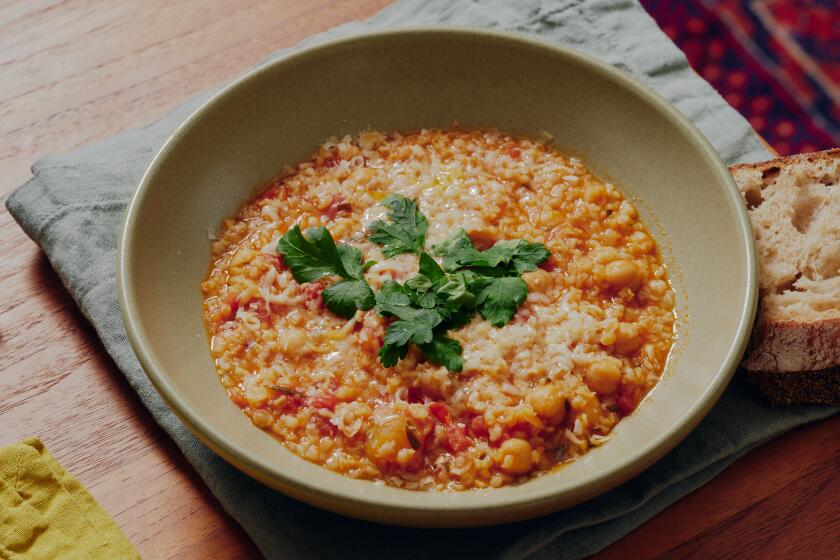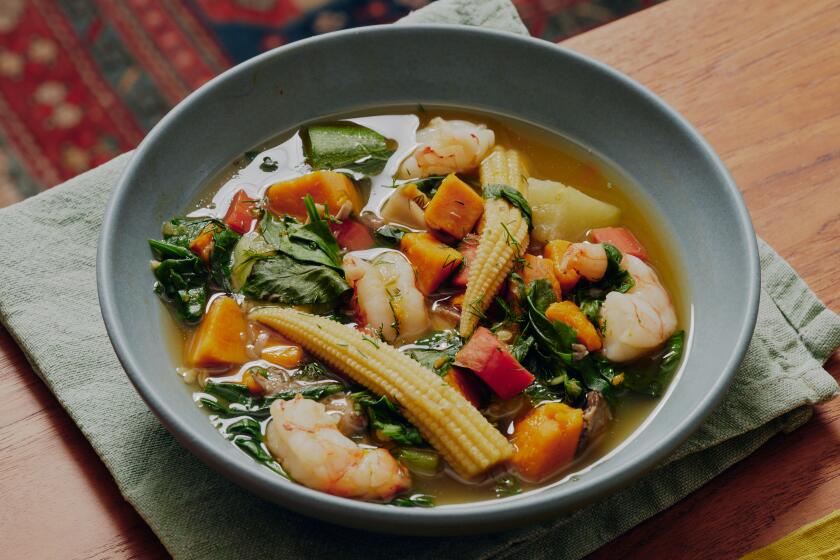Couscous with seven blessed vegetables
It seems like Rosh Hashanah customs were created by lovers of fruits and vegetables. Most families will begin Sunday nightâs holiday dinner with apple wedges dipped in honey to symbolize the hope for a sweet new year, and many serve sweet vegetables, especially carrots and sweet potatoes.
We like the Sephardi custom of starting the meal with a mini-Seder, a ritual derived from the Talmud. Guests sample small portions of certain vegetables and fruits, such as pumpkin, leeks, chard, black-eyed peas, pomegranate seeds and dates, and say a blessing with each one. The choices vary depending on whatâs available at the market -- pumpkin might be replaced by other squashes, black-eyed peas by other beans, and chard by beet leaves or spinach.
And the blessings vary depending on the community and individual home. Some blessings have roots in Talmudic symbolism. Pomegranate seeds are served because they stand for the wish that oneâs mitzvot, or good deeds, be as numerous as the fruitâs seeds, which are said to be 613, the same as the number of commandments in the Torah.
Other blessings are actually puns on the Hebrew or Aramaic names of the foods. The word for black-eyed peas, for example, sounds like the word for increase, and therefore the blessing is âmay our merits increase.â
To make the blessings more meaningful, some create puns based on the language spoken in their home. Suggestions for English speakers include eating peas as a hope for peace. Some of these have quite different meanings than in other languages. When eating dates, the traditional saying âmay our enemies be destroyed,â based on the Hebrew word for date, could be replaced by wishing single friends âhappy dating.â
Because of the emphasis on sweetness for Rosh Hashanah, some avoid lemon juice and other sour ingredients and sharp foods like chiles. There are those who donât even eat nuts because the Hebrew words for ânutâ and for âsinâ have the same numerological value.
One of our favorite Jewish New Year customs, observed on the second day of the holiday, calls for eating an exotic fruit or one that has just come into season and reciting a blessing that expresses gratitude for having lived to this joyous day. We enjoy sampling several fruits, such as fresh yellow dates that have turned honey-brown, Asian pears, Keitt mangoes, dragonfruit, lychees or even durian. But the fruits over which we recite this blessing most enthusiastically are fresh figs, preferably from our garden.
If using dried chickpeas, put them in a small saucepan and add 3 cups water. Cover and bring to a boil over medium heat. Simmer over low heat for 1 hour, adding additional hot water if necessary to keep them covered. Add a pinch of salt and simmer until tender, about one to 1 1/2 hours more. Remove from heat and set the chickpeas aside, still in their liquid. If using canned chickpeas, drain and rinse the chickpeas, cover and set aside.
Cut off the dark green tops of the leek and rinse them thoroughly. Put the leek greens in a couscous or soup pot or a large stew pan. Set aside the rest of the leek to use later.
Add the chicken to the leek greens in the pot. Add the quartered onion, celery ribs and enough water to cover the ingredients, about 8 to 10 cups. Bring to a boil over high heat, skimming any foam that forms on the surface. Reduce the heat to low and simmer for an additional 10 minutes, skimming any foam. Add the sprigs of cilantro and parsley, the saffron and a pinch each of salt and pepper.
Cover and simmer over low heat until the chicken is just tender and the meat near the bone is no longer pink, about 45 minutes; when the chicken is pierced in its thickest part with the point of a knife, any juices that come out should be clear, not pink. Discard the soup vegetables and herb sprigs. Remove the chicken with a slotted spoon and cool the chicken and broth separately. (The recipe can be prepared up to this point a day or two in advance; cover and refrigerate the broth, chicken and chickpeas until needed.)
Skim any fat from the surface of the broth, then bring the broth back to a boil over high heat. Add the tomatoes, kabocha squash, carrots and turnips to the broth. Cover and simmer over medium-low heat for 15 minutes.
While the broth is simmering, cut the white and light green part of the leek in half lengthwise and rinse it thoroughly, checking to make sure there is no sand between the layers. Cut the leek crosswise into 1 1/2- to 2-inch pieces and check again for sand.
Add the leek to the broth. Add the cooked chickpeas, along with their liquid if desired, or the drained canned chickpeas. Return broth to a simmer. Cover and cook over low heat for 5 minutes, then add the Mexican squash and return to a simmer. Cover and cook until the vegetables are tender but not falling apart, about 7 minutes.
Remove 4 cups of the vegetables with a slotted spoon. Remove the kabocha squash pieces and cut them into bite-sized cubes. Add them to the other vegetables.
To reheat the chicken, add the pieces to the hot broth and simmer them gently until heated through, 10 to 15 minutes.
Heat the oven to 400 degrees. Place the removed 4 cups cooked vegetables in a shallow 2-quart baking dish, drizzle with 1 tablespoon olive oil and sprinkle with the sugar. Bake the vegetables until they brown lightly, about 20 minutes. Sprinkle them lightly with cinnamon. Serve them as an appetizer or as an accompaniment for the couscous.
If you would like to brown the chicken, remove the hot chicken pieces from the broth, draining them well. Put them in a roasting pan. Drizzle them with 2 to 3 teaspoons olive oil, rub the oil over the chicken and sprinkle lightly with salt and paprika. Bake the chicken, uncovered at 400 degrees, until lightly browned, about 15 minutes. If you like, separate the drumsticks from the thighs. Transfer the browned chicken to a platter; cover and keep warm. If not browning the chicken, serve the reheated pieces on a platter, or remove the skin and bones and serve the cut-up meat in the broth.
Heat the broth with the vegetables until very hot. Drain the vegetables if you want to serve them on the side, or leave them in the broth. Add the chopped cilantro and parsley. Taste and adjust seasoning, adding cayenne if desired.
To serve the couscous, mound it in a cone shape on a large platter, garnished with the dried fruit and almond mixture as well as some of the vegetables. Serve the remaining dried fruit and almonds, vegetables and chicken in bowls or platters on the side.
Serve the couscous in shallow bowls. Serve the broth from a tureen, for moistening the couscous to each personâs taste. Top each portion with chicken, vegetables and fruit and almond garnish.
Get our Cooking newsletter.
Your roundup of inspiring recipes and kitchen tricks.
You may occasionally receive promotional content from the Los Angeles Times.















